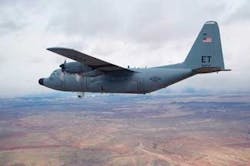LASER WEAPONS: Advanced tactical laser is ready for flight tests

This year the Advanced Tactical Laser (ATL) will finally get off the ground carrying a six-ton chemical oxygen-iodine laser (COIL) weapon module, for tests against ground targets. The beam-direction system in the C-130H aircraft was previously tested in flight with a low-power solid-state laser, and the COIL had been tested on the ground. In December, Boeing Integrated Defense Systems (St. Louis, MO) finished installing the laser module in the aircraft at Kirtland Air Force Base in New Mexico. The C-130H is a workhorse military plane used both for cargo and as a gunship, and will be the first combat-grade plane to fire a high-energy laser weapon at ground targets.
In the first half of this year, Boeing plans a series of tests starting on the ground “to retire risks” one at a time, says Gary Fitzmire, vice president and program director for directed-energy systems at Boeing. Then other tests will follow in the air, first flying the plane with the laser installed, and then adding the chemical fuels, and by mid-year firing the laser in the air at ground targets, including moving trucks as well as stationary objects.
Started in 2002 under a $176 million contract, the ATL is intended to demonstrate what Boeing calls a “laser gunship,” which can hit “tactically relevant” targets in a war zone. The plane itself is a battle-tested four-engine prop aircraft designed during the Korean War and first flown in 1954, which has been armed with gatling guns, howitzers, and bombs for various missions. Planners hope that the laser version can destroy or disable tactical targets in dense urban settings without the collateral damage caused by conventional munitions. That would allow targeting some previously unhittable enemy targets. A laser could make a pinpoint strike to disable the controls on a rocket launcher in a hospital courtyard, for example, without killing civilians, Fitzmire says. “We’re not competing with kinetic energy weapons; we’re trying to add capability.”
ATL vs. ABL
The output power of ATL is classified, but it’s much lower than that of the megawatt-class Airborne Laser, which combines the beams from six sport-utility-vehicle-size COIL modules onto a target and fills the interior of a Boeing 747. That plane has a nominal cargo capacity about six times the 22 tons of the more maneuverable C-130. A reasonable estimate of the output power is in the low hundreds of kilowatts. The ATL module takes up much of the C-130’s cargo space because it includes a large tank that collects all exhaust so the system can operate at any altitude-unlike the open-cycle ABL, which vents exhaust into the atmosphere at higher elevations.
Another key difference is that ATL does not use an adaptive-optics system because it fires only at nearby targets. The ABL requires adaptive optics to hit boost-phase missiles at distances of a couple of hundred kilometers. The ATL is not designed to fire at air targets; its beam emerges through a rotating turret beneath the aircraft fuselage.
Once Boeing has completed the ground-target tests, it will transfer the plane to the Air Force for extended evaluation, including tests by combat specialists to see how lasers might meet their war-fighting requirements. Ground forces have been reluctant to deploy chemical lasers requiring special fuels because disruptions of military supply chains could leave the laser inoperable in combat. Solid-state lasers could overcome that logistics issue because they could be powered by generators using standard diesel fuel.
The ATL developers have also thought about solid-state lasers. “Everything we learn here about how to take this laser through the beam-control system and onto a stationary or moving target from the air is relatable to solid-state lasers,” Fitzmire says. The beam-control system could be modified for use with solid-state lasers by changing optical coatings to work at the solid-state wavelengths. The challenge then would be to develop a suitable high-power solid-state laser able to operate on a vibrating aircraft platform.
Outside observers are skeptical that ATL will pave the way for practical laser weapons. “It’s more of a harassment weapon than anything else,” says Philip Coyle, senior advisor at the Center for Defense Information (Washington, D.C.) and a former director of military testing. He says the laser would not be effective against hardened targets such as tanks, and that targeting individual soldiers would raise ethical concerns about blinding weapons. He suggests that laser weapons might be useful only against “very soft targets” such as pickup trucks and tents.
About the Author
Jeff Hecht
Contributing Editor
Jeff Hecht is a regular contributing editor to Laser Focus World and has been covering the laser industry for 35 years. A prolific book author, Jeff's published works include “Understanding Fiber Optics,” “Understanding Lasers,” “The Laser Guidebook,” and “Beam Weapons: The Next Arms Race.” He also has written books on the histories of lasers and fiber optics, including “City of Light: The Story of Fiber Optics,” and “Beam: The Race to Make the Laser.” Find out more at jeffhecht.com.
